Birding South Bay Beaches, Santa Barbara County, CA (April 2004)
With snow showers still in the forecast in Pittsburgh, the Susoeff family smugly headed west to California over Spring Break. We left Friday, April 2, with Los Angeles as our first destination. Husband Eric is a native Californian and a surfer, so the trip was as much about seeing his family and catching some waves as it was about birding! California is one of the few places where those disparate passions, surfing and birding, can both be fulfilled. Costa Rica also comes to mind, but that's another story!
Our first day was spent in the South Bay Beach towns with Eric's family, and we quickly chalked up the urban birds you'd expect- Crows, Starlings, House Sparrows (although blessedly less than in my neighborhood), Rock Pigeons, Mourning Doves and House Finches. But the fun began when we went down to King Harbor in Hermosa Beach to spend time on my brother-in-law's 33-foot sailboat. Seals, Brown Pelicans, various gulls (see list), D.c. cormorants, Great Blue Herons, Black-crowned Night Herons, Willets, Spotted Sandpipers and a pair of Mallards were all in evidence. Our last bird for the day was a Barn Swallow that repeatedly perched on the boat in the next slip and watched us with as much interest as we watched it.
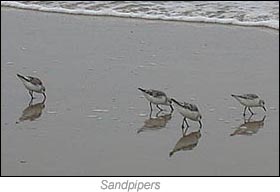 Saturday was another beach and sailing day for us. During an early morning walk we spotted an Anna’s Hummingbird
and a Yellow Warbler, as well as Swifts and a Northern Mockingbird. I assume the swifts were Vaux's. The most exciting
find of the day was a little Red-necked Phalarope, spinning around in the water in the harbor. It was a mere three yards
from the boat all morning and ended up hanging out at the harbor for a few days.
Saturday was another beach and sailing day for us. During an early morning walk we spotted an Anna’s Hummingbird
and a Yellow Warbler, as well as Swifts and a Northern Mockingbird. I assume the swifts were Vaux's. The most exciting
find of the day was a little Red-necked Phalarope, spinning around in the water in the harbor. It was a mere three yards
from the boat all morning and ended up hanging out at the harbor for a few days.
On Sunday we added Western Grebes to the list — a whole bunch of them swimming in the harbor. Many had their heads tucked under their wings while floating in the water.
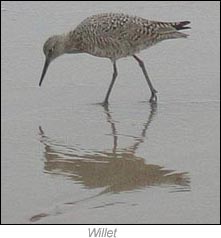
As much as I enjoyed the sailing and beaches, the part of the trip I was looking forward to most began on Monday, when we piled in the rental car and headed north for Santa Barbara County. We had a cabin reserved for one week at El Capitan Canyon, a "luxury campsite" that was recently featured, much to our surprise, in Travel & Leisure Magazine. On our way to the cabin, we planned to stop at several nature preserves and surf spots.
Our first stop was Point Dume and the nature preserve at Zuma Beach.
This is a lovely spot with a hiking trail that climbs from the uncrowded beach up to the top of a cliff
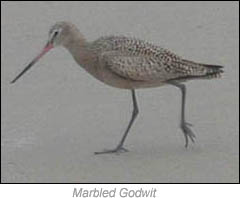 overlooking the ocean. While Eric watched the numerous surfers at this famous point-break, Patrick and I (with
daughter Liadan’s help) added Hooded Oriole, Bushtit, Wrentit, Brewers Blackbird, White-Throated Swift,
White-Crowned Sparrow, a Buteo species and a Merlin to our trip list. We were already at 29 species and we
hadn’t even reached our ultimate destination!
overlooking the ocean. While Eric watched the numerous surfers at this famous point-break, Patrick and I (with
daughter Liadan’s help) added Hooded Oriole, Bushtit, Wrentit, Brewers Blackbird, White-Throated Swift,
White-Crowned Sparrow, a Buteo species and a Merlin to our trip list. We were already at 29 species and we
hadn’t even reached our ultimate destination!
After a few more stops (mostly surf-related), we pulled into El Capitan Canyon. We got out of the car and wow! Birds
were everywhere, and most were life-birds for us.
Patrick and I couldn’t call them out fast enough: California
Towhees in the leaf-rubble, 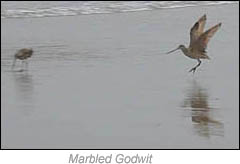 Western Scrub-Jays at the picnic tables, a pair of nesting House Wrens, numerous Spotted Towhees, flocks of Golden-Crowned and
White-Crowned sparrows feeding in the grass almost at our feet. Acorn Woodpeckers were abundant and the surrounding trees were
scarred with their holes. Western Bluebirds flitted from cabin to cabin. Black Phoebes bobbed their tails from fence posts.
Western Scrub-Jays at the picnic tables, a pair of nesting House Wrens, numerous Spotted Towhees, flocks of Golden-Crowned and
White-Crowned sparrows feeding in the grass almost at our feet. Acorn Woodpeckers were abundant and the surrounding trees were
scarred with their holes. Western Bluebirds flitted from cabin to cabin. Black Phoebes bobbed their tails from fence posts.
Our cabin was one of many ideally situated for birding. Outside the front door was a large sycamore tree and behind that, El
Capitan Creek ran by, its banks overgrown with willow. We saw Common Yellowthroats, Yellow and Yellow-Rumped Warblers, and
added the Bullocks Oriole, Blue-Gray Gnatcatcher and Robin to our list. 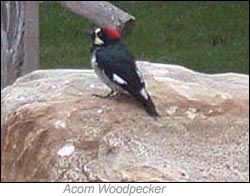 I went into the cabin to start unpacking
when Patrick yelled: "Mom, did you say you wanted to see the state bird?" There they were — a flock of
California Quail bobbing through the grass just a few yards away. This became a regular site each evening.
I went into the cabin to start unpacking
when Patrick yelled: "Mom, did you say you wanted to see the state bird?" There they were — a flock of
California Quail bobbing through the grass just a few yards away. This became a regular site each evening.
The next day, an early morning walk to nearby El Capitan Beach netted us a California Thrasher, Song Sparrow and Turkey
Vulture. Hiking was definitely the creme-de-la-crème at El Capitan. As its name implies, the cabins are nestled on
about 300 acres in a canyon, with walls rising on either side. The owners deeded another 3,000 acres surrounding the site
to the Trust for Public Lands, so the area is remote and pristine.
The camp offers several trails of varying difficulty.
Along with a map, the camp's kiosk had tips on what to do if one encounters a rattlesnake or a mountain lion.
We saw
neither, but other hikers saw a bobcat just ahead of us on the trail. 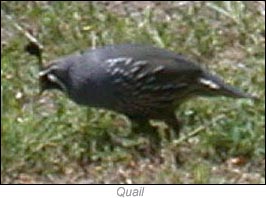 We saw its scat in several places, probably marking
its territory. On our hikes about the canyon (when we weren’t looking over our shoulders nervously for a
stalking cat) we added Lesser Goldfinch, White-tailed Kite, Canyon Wren, Oregon Junco, Northern Harrier, Northern
Rough-winged Swallow, Nuttal's Woodpecker and the "Red Shafted" Northern Flicker, as well as rabbits,
lizards and, I'm sorry to say, some feral cats.
We saw its scat in several places, probably marking
its territory. On our hikes about the canyon (when we weren’t looking over our shoulders nervously for a
stalking cat) we added Lesser Goldfinch, White-tailed Kite, Canyon Wren, Oregon Junco, Northern Harrier, Northern
Rough-winged Swallow, Nuttal's Woodpecker and the "Red Shafted" Northern Flicker, as well as rabbits,
lizards and, I'm sorry to say, some feral cats.
By mid-week, we were completely used to the Scrub-Jays and Western Bluebirds on our porch-rails and took the flocks of sparrows foraging in the grass for granted. We did, that is, until Patrick noticed one was a Lark Sparrow. Shame on us for always assuming they were 'just' White-Crowned or Golden-Crowned! We had also added Bewick's Wren and Caspian Tern to the list.
El Capital Canyon is a wonderful "base camp" from which to explore gorgeous Santa Barbara County.
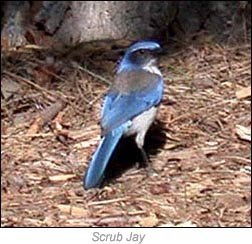 One of our destinations was Los Padres National Forest, which we accessed from a few different points. The first sojourn
was to Figueroa Mountain, because California Condors were "possible” according to the local birding club's
website. We drove up hair-raising, one-lane dirt roads without guardrails, looking down sheer drops of unknown but
very dramatic depths. This driving was not for the faint of heart. Unfortunately, we did not see a Condor, but several
Yellow-billed Magpies obligingly jumped out into the road in front of our car and stayed for so long we got a decent
picture of them! We also saw a fawn, and added Red-wing Blackbirds to our list. Incidentally, the wildflowers were in
full bloom and breathtaking. The California poppies were especially striking amid the sagebrush.
One of our destinations was Los Padres National Forest, which we accessed from a few different points. The first sojourn
was to Figueroa Mountain, because California Condors were "possible” according to the local birding club's
website. We drove up hair-raising, one-lane dirt roads without guardrails, looking down sheer drops of unknown but
very dramatic depths. This driving was not for the faint of heart. Unfortunately, we did not see a Condor, but several
Yellow-billed Magpies obligingly jumped out into the road in front of our car and stayed for so long we got a decent
picture of them! We also saw a fawn, and added Red-wing Blackbirds to our list. Incidentally, the wildflowers were in
full bloom and breathtaking. The California poppies were especially striking amid the sagebrush.
Although we hated to leave the quiet of campfire dinners in the canyon, the pleasures of Santa Barbara beckoned so we
dined in town one night. 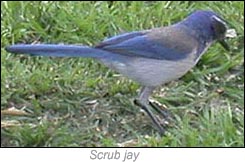 At the harbor we saw Western Gulls, American Coots, Pied-billed Grebes, and Whimbrels, bringing
us to 71 species.
At the harbor we saw Western Gulls, American Coots, Pied-billed Grebes, and Whimbrels, bringing
us to 71 species.
Santa Barbara County is known as horse and farm country, and our ride along Refugio Canyon Road the next day proved it.
We drove past avocado and lemon groves and saw an American Kestrel hunting in a field near a horse farm. We wanted a
Roadrunner in the worst way, but did not add any new birds to our list.
On our last day,
we hiked a portion of the El Capitan Canyon's longest trail. Right outside the cabin we saw a Swainson's Thrush. As we
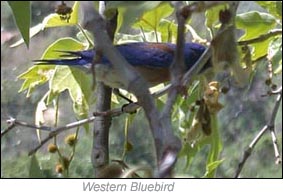 walked up the trail we saw a White-tailed Kite hunting, and enjoyed for the last time the many species that make the
canyon their home.
walked up the trail we saw a White-tailed Kite hunting, and enjoyed for the last time the many species that make the
canyon their home.
On the way back to Redondo Beach before flying home, we stopped at several famous surf spots including Rincon and Mailbu, where we added Black Scoter, Bonaparte’s Gull and Common Tern to our list. The morning we left for our flight, a flock of parakeets flew over – our last species for the trip. In all we counted 77 species and added several life birds. But we missed that Greater Roadrunner, so I guess we'll just have to go back!
| Species List | |||
| Canada Goose | Ruddy Duck | Red-bellied Woodpecker | American Tree Sparrow |
| Western Grebe | Whimbrel | Black Phoebe | Yellow-rumped Warbler |
| Pied-Billed Grebe | Red-necked Phalarope | Western Scrub-Jay | Common Yellowthroat |
| Brown Pelican | Bonapartes Gull* | Common Raven | Spotted Towhee |
| Double-Crested Cormorant | California Gull | American Crow | California Towhee |
| Great Blue Heron | Herring Gull | Northern Rough-Winged Swallow | Lark Sparrow |
| Black-crowned Night-Heron | Western Gull | Barn Swallow | Golden-crowned Sparrow |
| Mallard | Caspian Tern | Bushtit | White-crowned Sparrow |
| Black Scoter | Common Tern | Bewick's Wren | Song Sparrow |
| Turkey Vulture | Mourning Dove | House Wren | Dark-eyed Junco (Oregon) |
| Northern Harrier | Rock Pigeon | Canyon Wren | Brown-headed Cowbird |
| White-tailed Kite | Band-tailed Pigeon | Wrentit | Red-Winged Blackbird |
| Red-Tailed Hawk | Psittacidea species | Blue-Gray Gnatcatcher | Brewer's Blackbird |
| Merlin | White-throated Swift | Western Bluebird | Bullock's Oriole |
| American Kestrel | Anna's Hummingbird | American Robin | Hooded Oriole |
| California Quail | Acorn Woodpecker | Swainson's Thrush | House Finch (including yellow variant) |
| American Coot | Downey Woodpecker | Northern Mockingbird | Lesser Goldfinch |
| Killdeer | Nutall's Woodpecker | California Thrasher | American Goldfinch |
| Willet | Northern Flicker (Red-Shafted) | European Starling | House Sparrow |
| Spotted Sandpiper | Empid Flycatcher spp. | Yellow Warbler | |
*Note on the gulls. I stink at gull identification, and basically don't even try to id juveniles.
These were all adult birds and I made the call after careful and prolonged observation. I'm sure there
were many more different types that you experts would have gotten!
— by Joanne Scheier Susoeff & Patrick Susoeff





